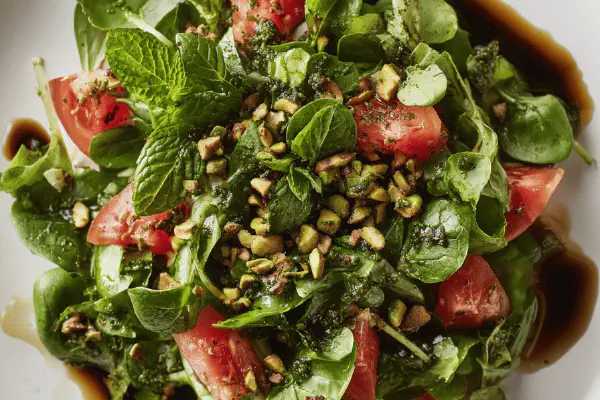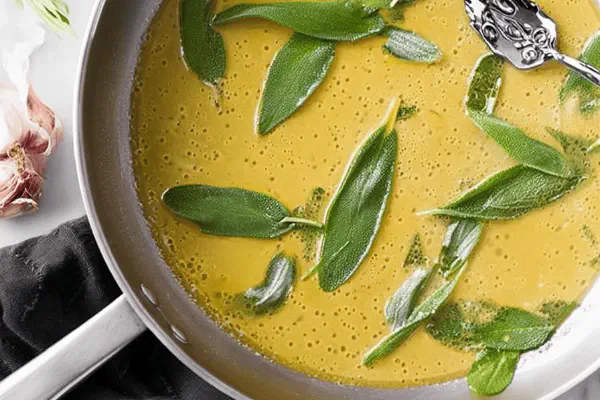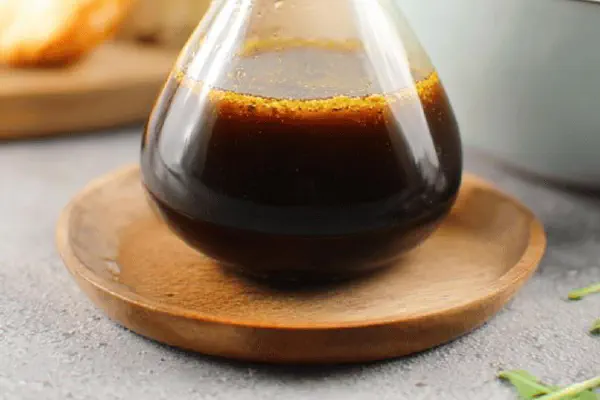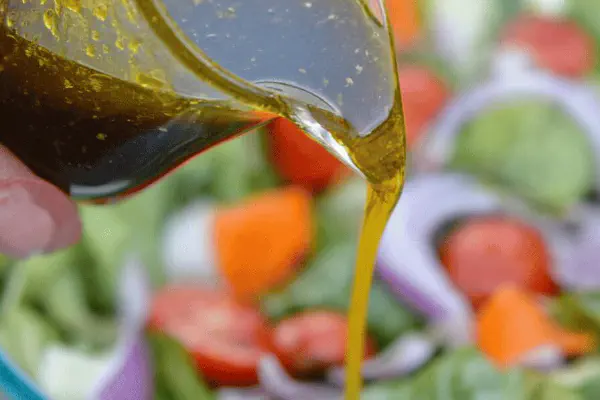Watercress Basil Vinaigrette

E
By Emma
Certified Culinary Professional
•
Recipe tested & approved
A quick vinaigrette blending peppery watercress and fresh basil with toasted pistachios and lemon. Uses grapeseed oil for a lighter finish and aged pecorino instead of parmigiano. Whirr everything to almost creamy but loose enough to drizzle. Salt and pepper bring balance. Great for greens or roasted veg. Substitutions suggested for nuts and herbs. Focus on texture and aroma to know when it’s done, with sensory cues for flow and seasoning.
Prep:
6 min
Cook:
0 min
Total:
6 min
Servings:
4 servings
#vinaigrette
#watercress
#basil
#pistachios
#pecorino
#green dressing
#European cuisine
#quick sauce
Green, sharp, with just enough texture. Not your usual vinaigrette, this one has bite and balance. Watercress punches through like early spring with peppery greens, but swapping basil softens it just enough. Pistachios toast like little flavor bombs; almonds work, but pistachios? Better. Pecorino’s unexpected saltiness adds depth; cheese matters here. Don’t blitz too far or you end with paste, not drizzle. I learned that the hard way—overdone garlic can wreck the whole batch. Speed and texture cues guide me more than time or measuring spoon. Oil trickling in slowly keeps it creamy yet fluid. Aroma changes from raw green to smooth herbaceous when it’s ready. Try once with garlic, next time with shallot; each twist tells a different story. Keep it fresh. Leftovers dull fast, green goes sad, flavors settle flat.
Ingredients
- 180 ml (3/4 cup) watercress, tightly packed
- 20 ml (1 1/3 tbsp) pistachios, toasted
- 1 small garlic clove, minced
- 70 ml (5 tbsp) grapeseed oil
- 25 ml (1 2/3 tbsp) freshly squeezed lemon juice
- 15 ml (1 tbsp) aged pecorino cheese, finely grated
- Salt to taste
- Freshly ground black pepper to taste
About the ingredients
Watercress must be fresh and crisp; avoid wilted or slimy bunches—grit hides well in those leaves so wash thoroughly. Pistachios bring nutty sweetness when toasted—no oil needed, dry heat only to avoid greasy finish. If nuts are allergic or missing, toasted sunflower seeds are a decent stand-in, but note texture will shift. Garlic’s bite controls overall punch, mince finely rather than smash to prevent harsh overtones. Grapeseed oil chosen for neutral flavor and lightness; olive oil adds richness but risks overpowering basil notes. Pecorino duro is ideal, sharp and salty; substitute with aged manchego for different but compatible profile. Lemon juice should be freshly squeezed, bottled juice lacks brightness. Adjust salt with care because cheese adds hidden salt. Black pepper fresh cracked for aroma; skip grinding too fine to preserve flavor bursts. Basil substitution softens watercress sharpness—try 50/50 blend to balance peppery and sweet herbal notes. Experiment with shallot in place of garlic for softer edge when preferred.
Method
- Start by rinsing watercress thoroughly; grit will ruin texture. Shake dry or spin in salad spinner until just damp, not wet.
- Toast pistachios in dry pan over medium heat, stirring until fragrant and slightly bronzed; about 3-4 minutes. Watch closely – nuts burn fast and bitterness kills dressing.
- Place watercress, toasted pistachios, garlic, lemon juice, and pecorino into blender or food processor bowl.
- Pulse a few seconds to break down leaves and nuts; stops overprocessing that turns vinaigrette bitter and pasty.
- Stream in grapeseed oil slowly while blender runs or pulse again with oil added gradually. Aim for loose puree but still pourable—too thick means no good on salad.
- If too thick, add a tablespoon of cold water or lemon juice, blend briefly. Look for texture between pesto and vinaigrette. Should coat spoon thinly, not cling like paste.
- Taste. Add salt carefully, little at a time, because cheese adds salt already. Pepper after salt, freshly ground for bite.
- Serve immediately or store in airtight jar. Keeps a day in fridge, but oil may solidify; let sit at room temp before using.
- Common screwup is overblending garlic– can turn harsh. Minced rather than pulverized keeps it balanced.
- If pistachios missing, swap for blanched almonds or toasted sunflower seeds; nuts add body and aroma, so pick toasted toasty, not raw.
- Basil instead of cress changes character—use half watercress, half basil if you want herbaceous brightness without too much pepper punch.
- Garlic can be swapped for shallot for milder, sweeter note.
- Aged pecorino stands in for parmigiano well here; adds sharp umami but a little saltier, adjust seasoning accordingly.
- Listen for blender buzz drop, smell nutty toasty aroma and bright lemon pop. These cues tell you it’s about done, no more than 5 minutes.
- Don’t skip oil slowly. Pour fast and vinaigrette separates or emulsifies poorly.
- Avoid over-salting upfront; cheese salts deeply dissolve in dressing.
- Use immediately; dressing sits acidic and green fades after hours.
Cooking tips
Always dry your greens well or dressing will become watery and fail to cling. Toast nuts over medium heat; smell switches from raw to toasted when done—don’t step away, nuts burn fast, and burnt nuts pollute the final flavor. Blend in short bursts; overblend and you risk overoxidation and bitterness. Add oil slowly, dribble it in to create emulsification; pours fast, dressing separates into oily slop. If too thick, coax with spoonfuls of water or more lemon juice—thin enough to drizzle but not watery. Salt at the end, taste after resting; cheese already salty. Pepper last, freshly cracked for spice and aroma. Use immediately; symptoms of old dressing include dull color and heavy mouthfeel. If refrigerated, oil solidifies—bring to room temp and stir to reincorporate. Swapping garlic for shallot frees garlicky bite for sweetness, watch the texture of mince so it blends evenly. Keep pulse blending not continuous; blenders heat leaves—heat diverts bright green into brownish dingy. Your senses, not timer, tell you when the vinaigrette is done—color bright, aroma nutty and fresh, texture smooth but pourable. Visual test: should drape salad leaves without clumping or running off.
Chef's notes
- 💡 Dry greens well; any water ruins cling. Shake or spinner only until damp. Too wet means watery dressing that slips off leaves. Grit hides in watercress—rinse thoroughly.
- 💡 Toast pistachios dry, medium heat. Watch! Nuts go from fragrant to burnt in seconds. Nutty aroma shifts. Burnt? Bitter wrecks all. Stir constantly, 3-4 minutes max, smell for toasty trigger.
- 💡 Blend pulse, not continuous. Overprocessing breaks oils releasing bitterness; vinaigrette gets paste-like and harsh. Stop when nuts and leaves break but still coarse. Texture matters more than time here.
- 💡 Add grapeseed oil in slow drizzle while pulsing. Pour fast and emulsion breaks, dressing separates. Aim loose puree, not thick paste. If thick, add cold water or lemon juice spoonful at a time.
- 💡 Salt last. Pecorino adds hidden salinity. Add gradually, taste often; overdosed salt kills balance. Pepper freshly ground, after salt, for aroma and subtle bite. No pre-salting or mixing salt early.
- 💡 Swap nuts if needed—blanched almonds or toasted sunflower seeds give good body but change texture. Pistachio oiliness is subtle, not greasy. Basil softens with half watercress for bright herbal edge, not overpowering.
- 💡 Garlic minced finely, never blitzed. Overblending garlic turns harsh, bitter, sharp. Shallot sub shifts bite to sweet, softens overall punch. Choose based on desired flavor profile; each alters texture slightly.
- 💡 Watch for sensory cues: blender buzz drops, aroma shifts from green raw to nutty toasted and citrusy lemon pop. Texture coats spoon thinly, drapes salad leaves without globbing or running off. This signals doneness.
Common questions
How to fix watery dressing?
Greens too wet. Spin longer or pat dry. Add water or lemon only if thick. Otherwise watery from washing or storage. Dry well, rinse grit carefully.
Nut substitutes?
Blanched almonds work well; sunflower seeds toasted ok but taste different. Skip oily nuts, dry toast only or flavor goes greasy. Keep nuts fresh; rancid kills dressing fast.
What causes bitterness?
Overblending garlic or nuts. Heat from constant blending heats oils, oxidizes. Blend pulse, stop once texture changes. Toast nuts right; too dark burns bitter. Use sensory cues.
How to store vinaigrette?
Airtight jar in fridge max one day. Oil solidifies cold, stir and bring to room temperature before use. Dressing dulls color/flavor fast, best fresh. No long storage or freezing.



